
Aizu-Wakamatsu
Aizu-Wakamatsu — City of Samurai and Sake
Aizu-wakamatsu is in a broad valley surrounded by mountains.
The area has been settled since prehistoric times.
The legends say that in 88 BCE Emperor Sujin
sent two generals to the area to re-establish control
after a failed rebellion.
The history of the samurai period is overwhelming,
because there's so much of it.
The daimyō were warlords with control
at local to regional scale,
commanding the samurai warriors.
The Emperor controlled the daimyō
initially,
but then from the 10th to mid 19th centuries CE
the Emperor mostly stayed at Kyōto and
performed Shintō rituals while
the daimyō, eventually under the
overall command of a shōgun,
ruled Japan.
Aizu-Wakamatsu became a prosperous market town and
a base for the series of warlords controlling the region.
One of them started building the city's first castle in 1384.
Let's see the history,
including what's probably more about microwave
telecommunications than you expected.
But this is Japan, a high-tech land.
Getting Started
Aizu-Wakamatsu was traditionally known for brewing sake and producing lacquerware. Today's main products are textiles, wood, and electronics. The population has grown to almost 120,000. As usual in Japan, the population doesn't seem nearly that high because of the high density of settlement and the cleanliness and efficiency of everything.
First, breakfast. There was a Family Mart convenience store a few blocks from my guesthouse along the historic Nanuka-machi-dori. They of course offer a wide variety of onigiri rice balls with fish at the center, bottles of green tea, plus a place to sit and eat breakfast. It looked out across a small plaza with some ham radio antennas rising it.

The two-element beam at left is probably for the 40m band (7.0–7.3 MHz in the Americas, 7.0–7.2 otherwise), given the loading coils plus the "capacitance hats" at the ends of the elements making them electrically longer. At right is a seven-element beam for the 15m band (21.0–21.45 MHz) below a four element beam for the 20m band (14–14.35 MHz).
North Americanham bands Japanese
ham bands
The 15m and 20m beams are Yagi-Uda designs, the most commonly used directional antennas on the HF, VHF, UHF, and low microwave bands, from around 7 MHz up through 2.45 GHz. Shintaro Uda invented the antenna design in 1926. However, his boss Hidetsugu Yagi published the first English-language description and got the credit to the point that they're commonly called Yagi antennas. There's one half-wave dipole element connected to the feed line, one slightly longer reflector element, and one or more slightly shorter director elements in the direction of greater receive sensitivity and transmitted signal radiation.
Tsuruga Castle
Visiting Kyōto Visiting NaraAizu-Wakamatsu Castle is also called Tsuruga Castle or Tsuru-ga-jō. An earlier castle was first built here in 1384, when the Ashina clan ruled the area during the Nanboku-chō jidai or the "North and South court period". The shōgun Ashikaga Takauji had established a Northern Imperial Court in Kyōto, while the Emperor Go-Daigo had established a Southern Imperial Court a short distance south of there near Nara.
The castle grounds are now a large city park surrounded by thick walls and a moat.
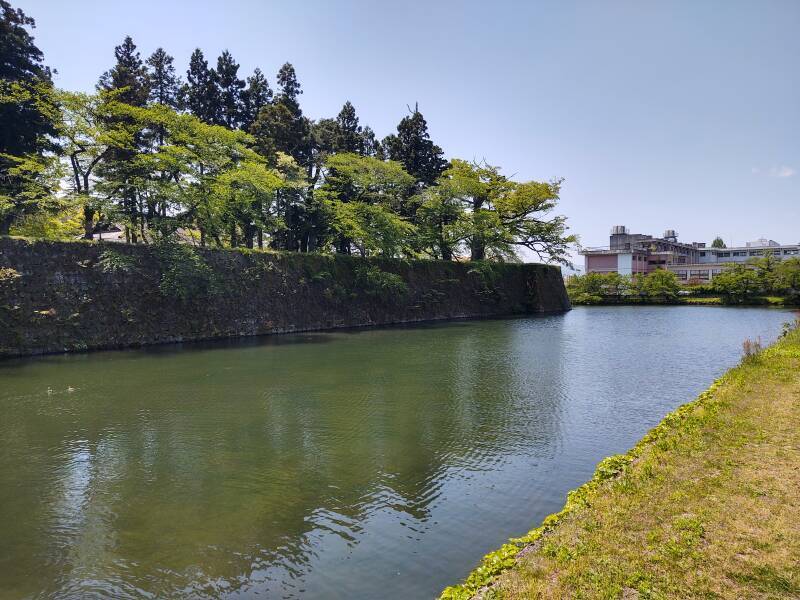
The walls are thick and tall, with the limited entries further protected by "bent gates" with two 90-degree turns.
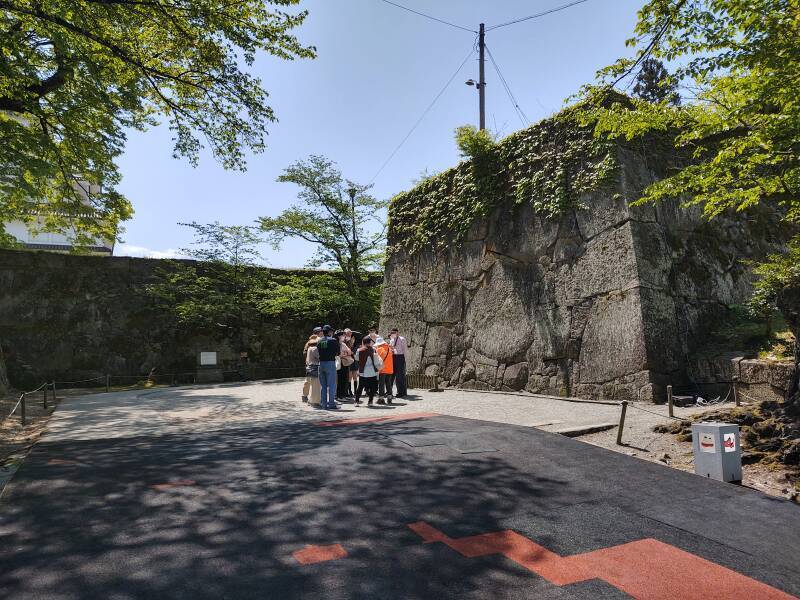
The daimyō ruled the region from here until the Meiji Restoration and the end of the shōgunate, when the Emperor returned to national secular power in 1868. As with many of the castles, the newly powerful Imperial government destroyed its tenshu or central keep. What you see today is a reproduction built in 1965. As usual with historic reconstructions built after the incendiary bombing raids of 1945, it's built from reinforced concrete crafted to look like the original material.
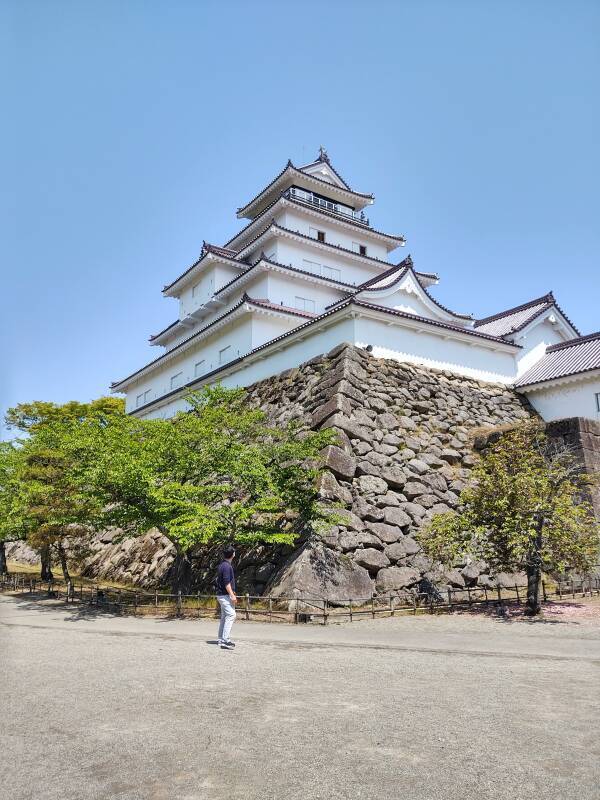
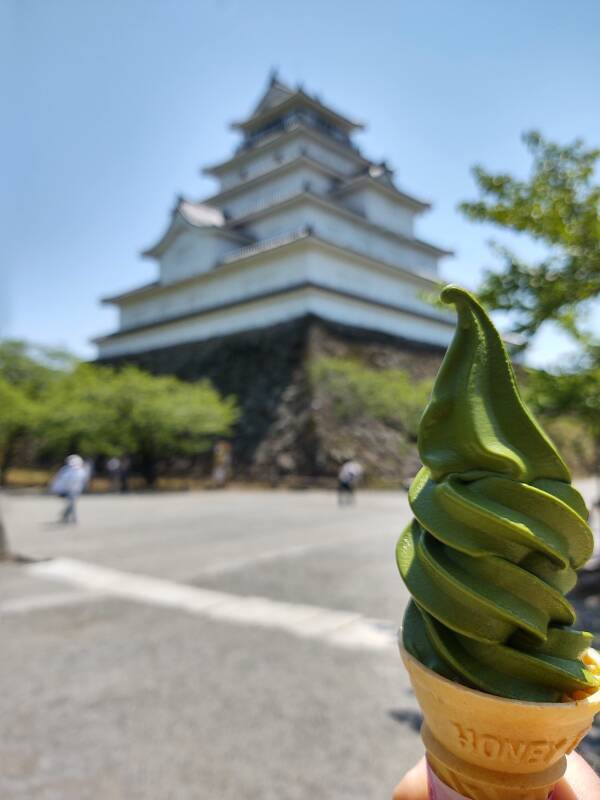
It's a popular park, so of course vendors sell アイスクリーム or aisu kurīmu. And of course they have ice cream flavored and colored by matcha powdered tea.
Akabeko the legendary cow is here. An even larger Akabeko nods endlessly at the main train station. Versions range in size down to small charms.


The castle had been rebuilt with an unusually large seven-story tenshu in 1592–1593. The tenshu was damaged by an unusually strong earthquake in 1611 and immediately rebuilt. It was quite strong for that period.
The shōgunate collapsed after being forced to capitulate to Matthew Perry's U.S. Navy fleet in 1853. There were several years of civil war, with the Meiji Emperor coming to full power in 1868. The Boshin War was the remaining year of civil war in 1868–1869, with the Battle of Aizu in October into November of 1868.
By 1868 the new government had western artillery and shelled the castle from the surrounding hills. The local daimyō surrendered in late November. The new government demolished the tenshu in 1874. What you see today is a reconstruction of what had been built in 1611 and used for over 250 years.

A groups of 22 loyal samurai retainers and their families managed to survive the final siege of 1868 and escape. They were led by a Prussian who was pretending to be a Dutchman while providing western weapons training to the shōgun, for which he had received samurai status. He chartered a ship and the samurai and their families sailed to San Francisco, California, where they established the first Japanese colony in America. It was the only samurai settlement ever established outside Japan.
They had brought mulberry and tea plant seedlings along with silkworm cocoons, and founded the Wakamatsu Tea and Silk Farm Colony outside Sacramento. They were able to show their produce the next summer at the 1869 California State Agricultural Fair. However, the colony failed in 1871.
If they had also made ice cream, the colony might have thrived.
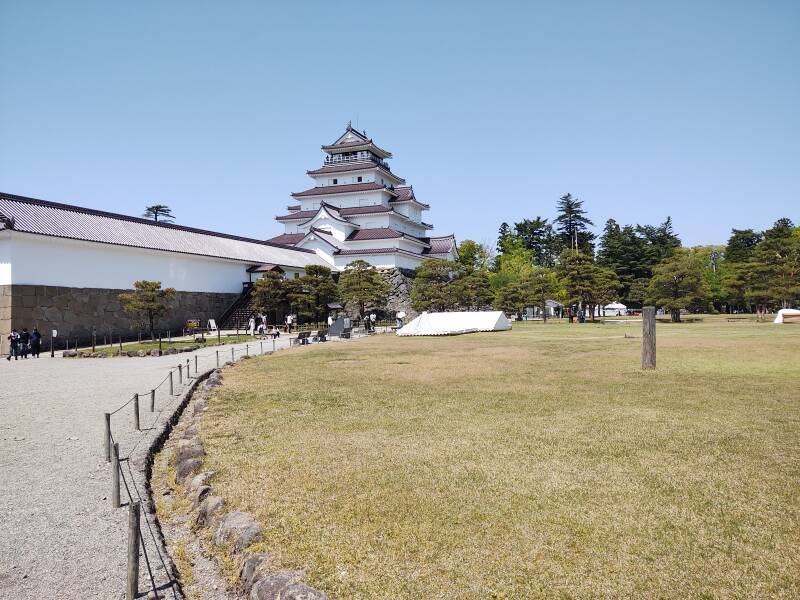
Much of the castle's land was sold to private owners, with only the central 23 hectares retained by the national government to serve as an Imperial Japanese Army garrison.
With the increasing nationalism leading up to World War II, the story of the Boshin-War-era Byakkotai unit became more popular. That led to the castle grounds becoming a public park and then designated a National Historic Site in 1934.
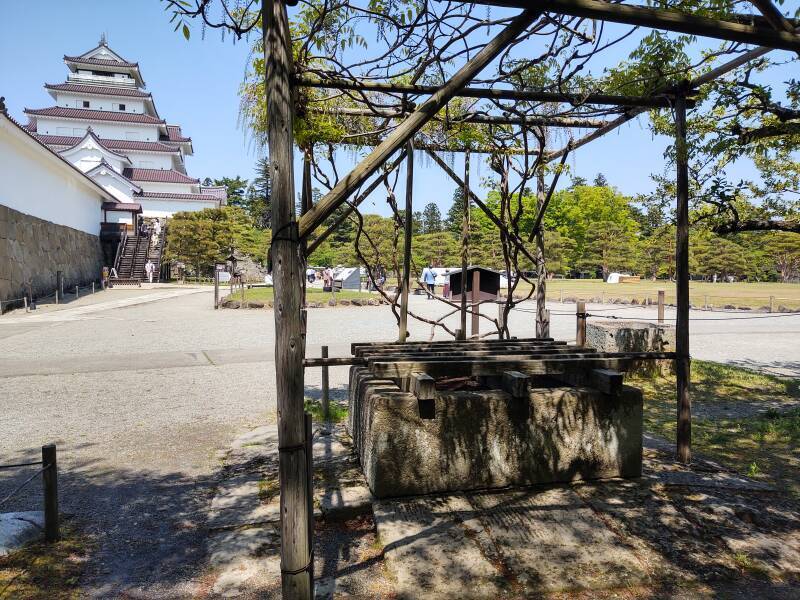
Parts of the water systems for the military horses remain.
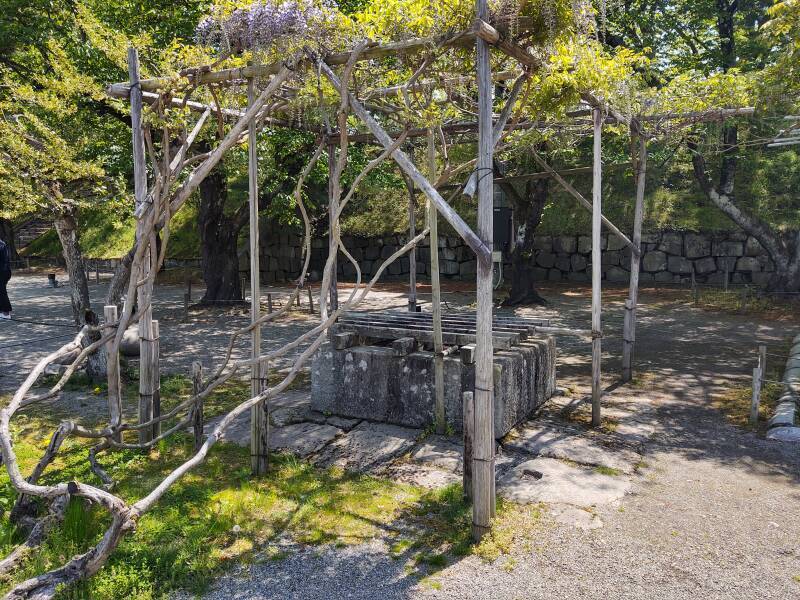
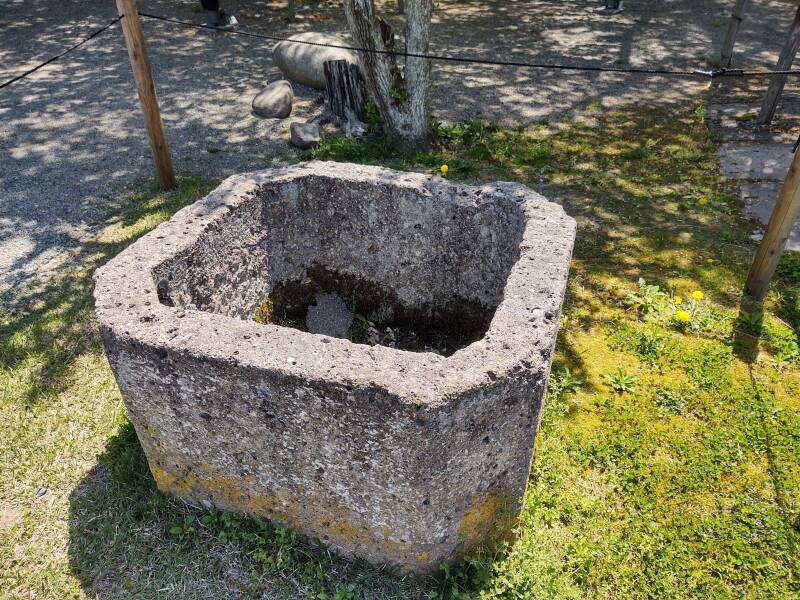
The shōgun and the samurai were Buddhist, while the Emperor was Shintō. Well, of course, since Shintō teaches that the Emperor is descended from the gods.
After centuries of Shinbutsu-shūgō or blending of Shintō and Buddhism, a typical Buddhist facility included Shintō features, and vice-versa. A small Shintō shrine and its multiple torii or gates stand along the inner walls near the tenshu.
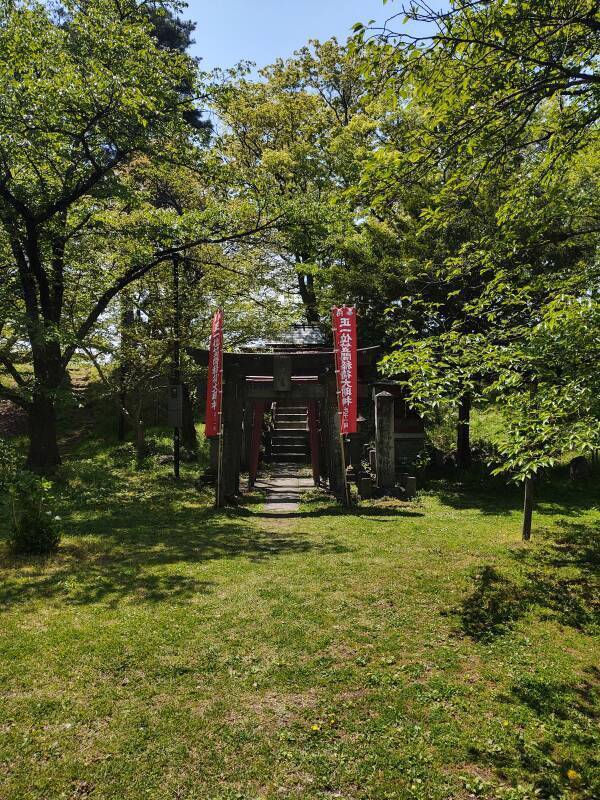

More ice cream was needed at this point, and a nearby stand offered wasabi flavored ice cream.
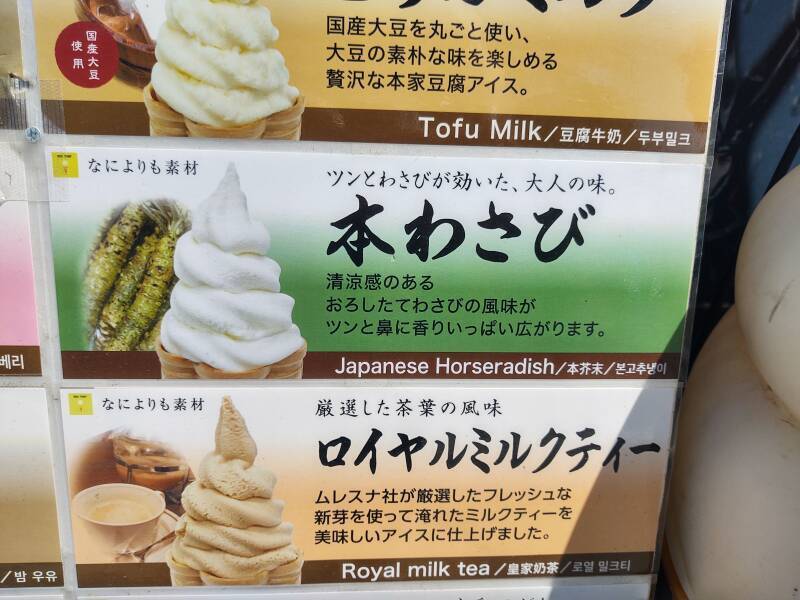
It says "Japanese Horseradish" in English, but the last three of the four large characters are わさび or wasabi. This is the stuff. Delicious.
Exploring Aizu-Wakamatsu
Smaller former sake breweries have been repurposed as shops and restaurants. They are built with window shutters that look like vault doors.

Aizu-Wakamatsu was a prominent sake producer. At least two of the larger old ones are still in operation, one close to my guesthouse. They had offered tours and a tasting room, but during my visit in 2023 those were still shut down by the COVID-19 pandemic.
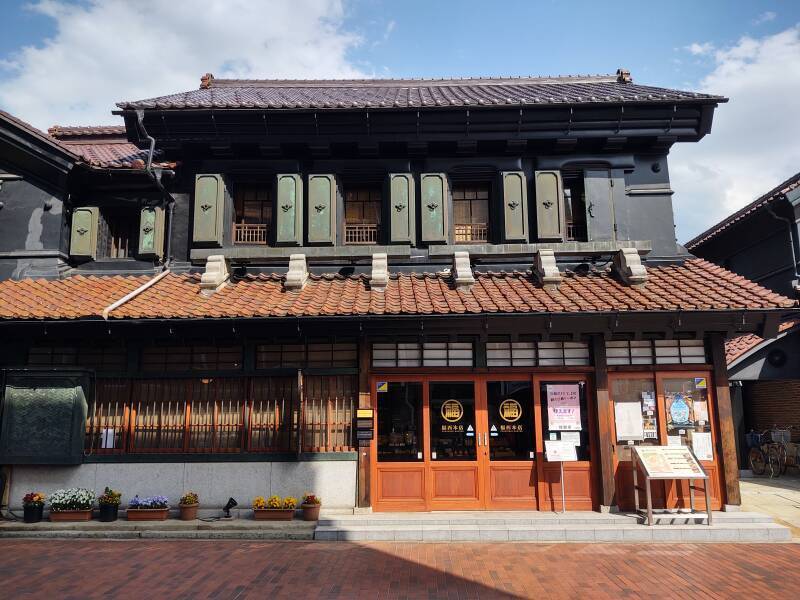

Of course bicycles are a popular form of transportation. And of course hundreds of bicycles will be parked along the sidewalks with no locks in sight.
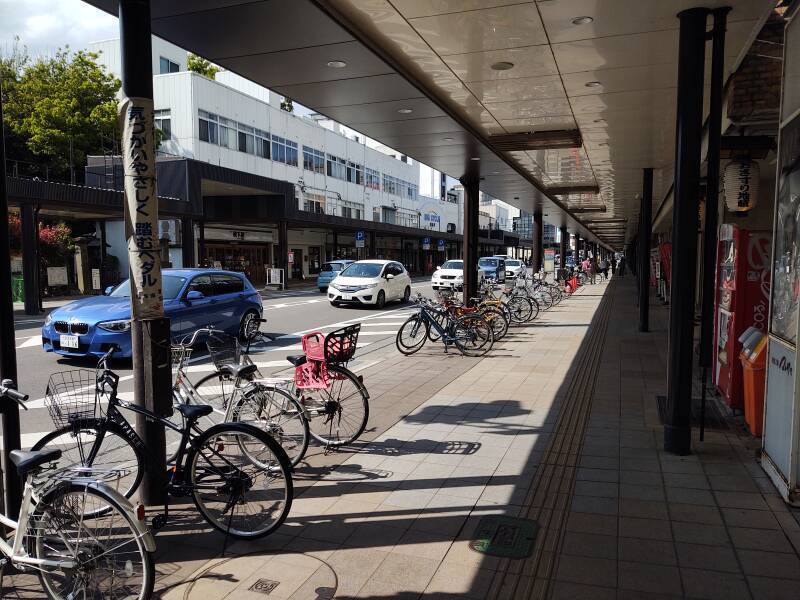
The Anti Aging Bank is near the center of downtown. It seems to be a fitness club rather than a financial institution.

Electricity, Ramen, and Telecommunications
On my way to get lunch one day, I was reminded why you see so many power lines in manga and anime.
It's because manga and anime come from Japan, and Japan is so obviously electrified.
You have no problem spotting overhead power and communications lines.
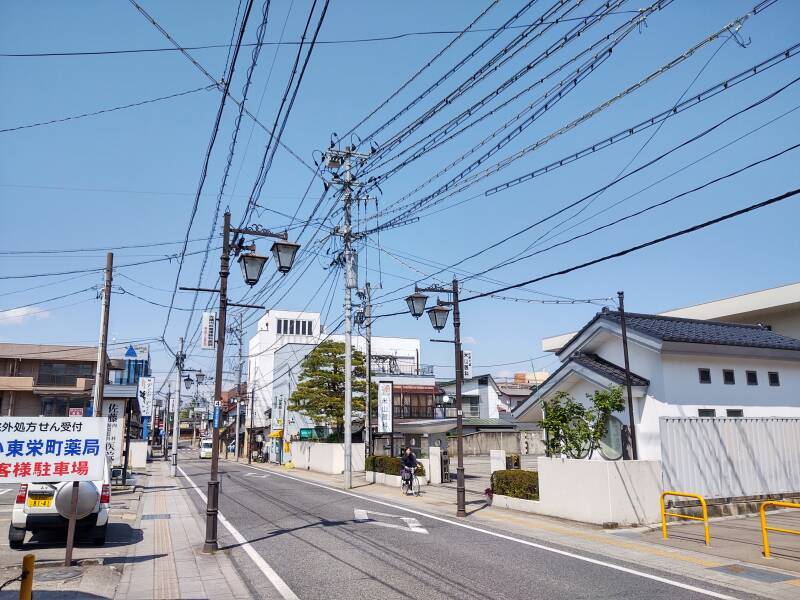
Then there are the largely empty wireless telecommunication towers, like this one seen in the distance beyond another small sake brewery. Largely empty, but still in use! The antennas have become much smaller.
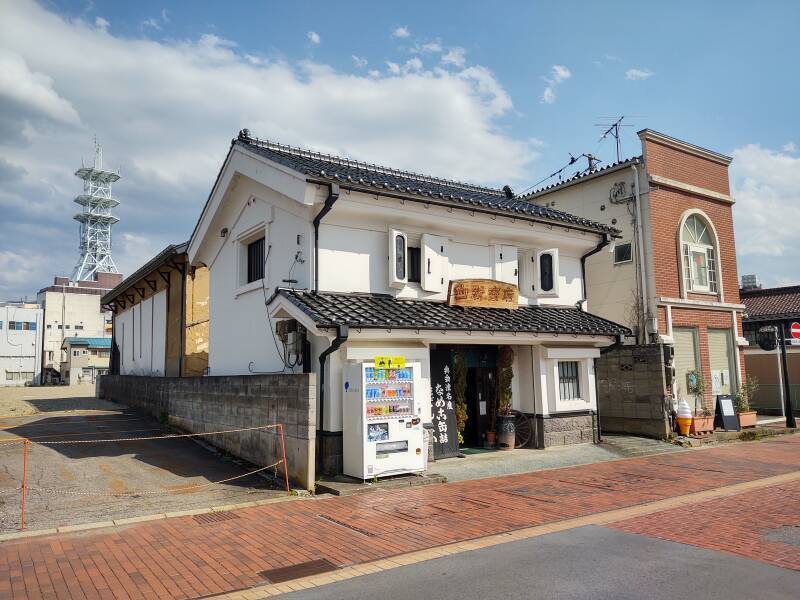
Electrically powered communications originally meant telegraph lines. Those ran along railroad lines, because the railroads needed to communicate between stations.
Wireless communication, meaning radio, began as Heinrich Hertz's experiments in the 1880s. Some of the early lab experiments involved microwave frequencies at GHz range and above, but the early practical systems used much lower frequencies, therefore much longer wavelengths. Signals at tens of kilohertz, with wavelengths of 1,000 to 10,000 meters, were found to follow the curvature of the earth and propagate beyond the visible horizon.
Bell Laboratories began experimenting with higher frequencies in the late 1920s and into the 1930s. Time and frequency division multiplexing allowed more and more telephony or voice channels, and thus telephone calls, to fit into one link.
Visiting Normandy World War II RadarCavity magnetrons were famously developed for radar during World War II, but those and improved klystrons were also being used to build links carrying multiple voice channels. One such system was used to provide communication for units in the June 1944 Normandy landings to communicate with forward units and with their headquarters in Britain.
As the end of the war was obviously coming, AT&T announced a plan in 1944 for 7,000 miles of coaxial cable carrying telephone calls and the new television signals. In 1950 that plan increased to 12,000 miles. However, that's an awful lot of cable to be strung between poles or buried in trenches along right-of-way routes that would have to be paid for. Projected microwave equipment costs showed that it would be cheaper to send signals through the air.
Signals below 1 GHz meant wavelengths and thus antennas that were impractically large. Rain scattered and absorbed signals above 10 GHz. Bell Labs researched systems operating between the two frequencies, and UHF troposcatter propagation was discovered.
Bell began building the experimental TDX system between New York and Boston in 1945. Seven repeaters relayed 3.9–4.4 GHz signals. It began carrying experimental television signals in November 1947. In 1948 the International Telecommunication Union allocated 3.7–4.2, 5.925–6.425, and 10.7–11.7 GHz for commercial "common carrier" use.
AT&T completed their TD-1 system in 1949, using the existing TDX hardware. Then in 1950 the TD-2 system provided more channels and greater range between repeaters. Telephone calls were looking more and more important, so multiplexers were expanded to carry 480 calls per channel. Links were built between New York and Chicago, and between Los Angeles and San Francisco.
The Treaty of San Francisco re-established peaceful relations between Japan and the Allies, ending Japan's status as an imperial power, allocating compensation to Allied nations and former POWs who had suffered Japan's war crimes, and ending the Allied occupation of Japan. U.S. President Harry Truman made an opening address at the treaty conference on 4 September 1951, and AT&T's microwave network carried it coast to coast. That is, between Los Angeles and San Francisco; from there to Chicago and on to New York; and from there north to Boston and south to Washington. Not along all of either coast, let alone everywhere in between nor out to the corners, but it was a big development.
Edward R Murrow's "See It Now" was the first regularly scheduled television program to be routinely distributed that way. That led to "American Bandstand" and sporting events being distributed live nation-wide. Microwave links continued to replace coaxial cable television networks into the 1960s.
Systems were continuously improved. Extended life for transmitting tubes, sharper bandpass filters. Bell Labs began developing the TH relay system in 1955. It used polarization to double the channel capacity.
To preserve the vertical versus horizontal polarization separation, rectangular horn antennas were used. Here's a picture from 2018 showing that type of antenna on a tower along the US 231 highway through Indiana. These were probably used until the 1990s. The feedlines were removed and the antennas left in place. The tower was still up because a few small circular dish and short whip antennas were still in use.
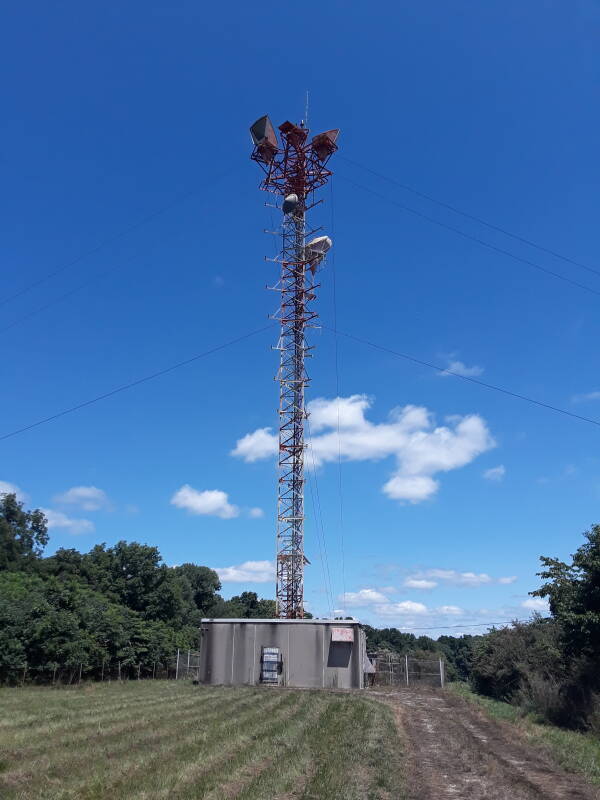
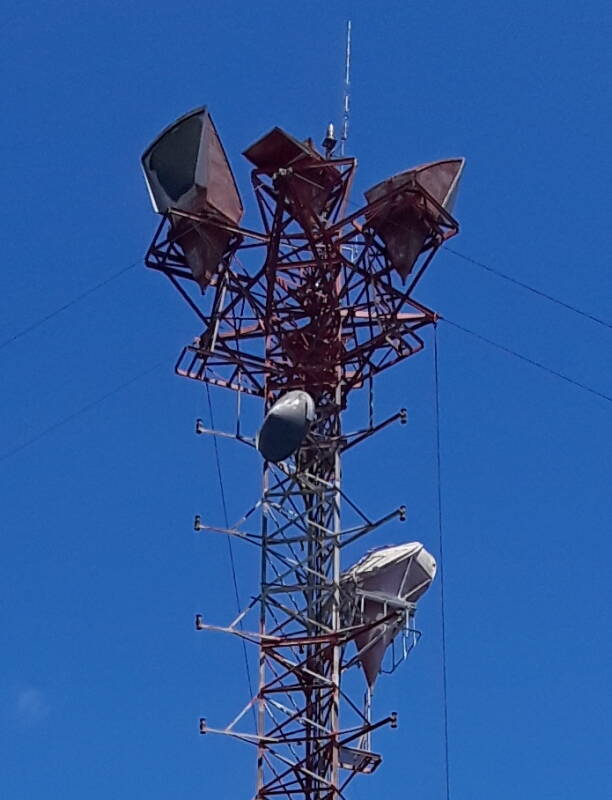
The second image is a cropped view showing two reddish-brown horn antenns pointing in opposite directions at the very top. There's a smaller round dish with a radome or cover below them. And below that is a white rectangular horn antenna pointing away and to the right. The waveguides feeding the antennas have been removed, you can clearly see how the two at the top taper down to their feed points but nothing connects there.
Horn antennas like those along with round dishes would have filled the large platforms on these towers in Japan.
The TD-2 system was re-engineered in 1962 as the TD-3. The all-solid-state receiver had a far lower noise floor, allowing another increase in channel count. The only remaining tube was the final amplifier, in which a travelling-wave tube had replaced the klystron. By 1968 the TD-2 and TD-3 were carrying 40% of long-distance telephony and 95% of television distribution in the U.S.
Television distribution quickly moved to satellites in the 1970s, and the telephony and data markets grew into the terrestrial microwave capacity. In that same decade, optical fiber and solid-state lasers were being developed. The 1980 Winter Olympics in Lake Placid, NY, used AT&T fiber networks to carry the television coverage.
Sprint Corporation in the U.S. grew out of two companies — the Brown Telephone Company that deployed an early rural telephone service in Kansas in 1899, and the Southern Pacific Company which owned the Southern Pacific Railroad.
The railroad operated thousands of miles of telegraph lines running alongside their rail lines. In the early 1970s the railroad began selling long-distance telephone service over those telegraph lines. The telco name was originally SPRINT, an acronym for "Southern Pacific Railroad Internal Networking Telephony".
In 1980, United Telecommunications, which was the result of Brown Telephone's mergers and name changes through the early 20th century, began building a 23,000 mile fiber optic network for long-distance phone calls as it merged into Sprint. In 1983, GTE bought the combined Sprint and SPC. The Sprint segment heavily marketed the low cost and high quality of fiber calls. "Dime a minute" and "Hear a pin drop" were slogans in the constant television commercials. By the 2010s, US$ 0.10 per minute for domestic calls would have seemed outrageously expensive.
AT&T began transitioning to digital signalling over fiber, and retiring their microwave towers. Most of the microwave network in the U.S. was shut down by the late 1990s. U.S. towers like the one shown above were sold off if any purchaser could be found.
By the early 2020s, some of the former TD-2 towers had come back into use. Microwave signals travel through air at close to the speed of light in a vacuum. Light pulses travel through optical fiber at a significantly slower speed. And, the microwave towers were placed along fairly straight paths between major cities, while fiber networks tend to follow much longer routes along rail lines and major highways. Finally, the fiber networks are packet-switched, adding further latency, while microwave signals can simply be relayed near-instantaneously through new antennas, receivers, and transmitters.
The resulting fiber latency is nothing you would typically notice in a voice call, just a few milliseconds. However, to high-frequency financial traders, that could be a big deal. By 2013 there were 15 microwave links between Chicago and New York, using previously retired towers, and other such links between major European trading centers. By the early 2020s, companies were developing high frequency radio links, meaning 3–30 MHz signals once called "short wave", to connect high-frequency trading in the financial sense. This 2018 Data Center Knowledge article describes a facility about 45 miles west of downtown Chicago. It's linked by a microwave dish to a data center 16 miles away, and by HF directional beams to New York, London, and Frankfurt. It's similar to other sites around Chicago and one in northern Indiana near Wanatah.
Back to Japan: The telecommunications infrastructure in Japan tended to use distinctive large antenna systems. A large tripod, likely built on top of a multi-story building to increase the range to the radio horizon, holds up three or more large platforms. The example in central Aizu-Wakamatsu is visible at a distance in the picture above, and closer up in the picture below.
These would be much nicer to work on, as maintenance wouldn't have to be done hanging off a tower that you had laboriously climbed up like a large ladder. Instead, walk up proper staircases and work on broad platforms. The telcos have removed the old large microwave antennas, leaving most of these towers in place. They're great platforms on which to mount small antennas for cellular service to nearby telephony customers, and relatively small dish antennas for the backhaul signals connecting the cell sites into the national network. The backhaul links are moving up in frequency to handle more and more bandwidth. Ericsson says here and here that by 2022–2025 the backhaul links were primarily 6–15 GHz, 18–24 GHz, and a pair of 70/80 GHz bands, rapidly moving to frequencies above 100 GHz by 2030.
I had reached my goal, the Kurukuruken ramen shop. It's the one-story yellow building seen below. A block beyond it, behind (of course) a variety of power and telco lines, stands a roughly 7–8 story brown building topped with one of those multi-platform towers.

There are counter seats, they directed me to a small table as they weren't busy.

Pay on your way out, at the register by the door.

It's a local joint with no English on the menu, but they are pictures of the セツト or setsuto, the sets or combination meals. And, I can spot ライス or raisu, and ギヨーザ or gyōza, and ビール or biru. I'll get by.
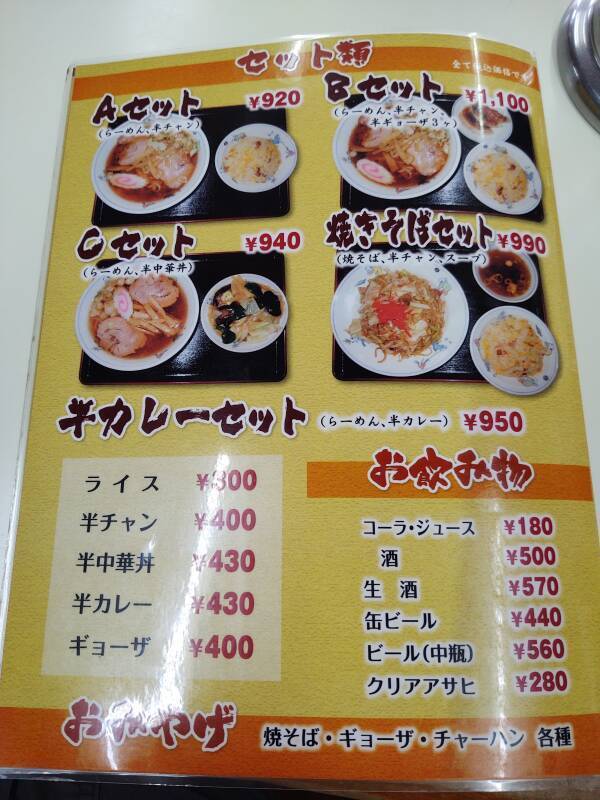
Setsuto A!

The next page explores a prehistoric kofun or megalithic tomb in Aizu-Wakamatsu
Other topics in Japan:




































High-frequency trading is a financial technique of turning the trading over to computer programs making transactions at millisecond timescales in hopes of making more money.
High frequency signals are radio signals in the range of 3–30 MHz, versus medium frequency at 0.3–3 MHz or 300–3000 KHz, low frequency at 30–300 kHz, very low frequency at 3–30 kHz, and very high frequency at 30–300 MHz, ultra-high frequency at 300–3000 MHz or 0.3–3 GHz, and so on. The names were chosen in the early to mid 20th century, reflecting the technology of the era.